AILET 2024 Ph.D. Question Paper with Solution PDF is available for download. NLU Delhi has conducted AILET 2024 on December 08, 2024. The question paper comprises a total of 150 questions divided among three sections.
AILET 2024 Ph.D. Question Paper with Solution PDFs
Question 1:
Consider the following list of statements:
I. Legislation is a primary source of legal authority.
II. Precedent is a primary source of legal authority.
III. Academic writings and textbooks are a primary source of legal authority.
IV. Common law is a primary source of legal authority.
Select the correct option:
a) All of the statements are correct.
b) All of the statements are incorrect.
c) Only statement (I) is correct.
d) Only statement (III) is incorrect.
Question 2:
Which one of the following is not a characteristic of action research?
a) Data are collected systematically.
b) Data are analyzed systematically.
c) Findings are generalizable.
d) Results are used to improve classroom practices.
Question 3:
Fact is "empirically verifiable observation" --- is defined by
a) P.V. Young
b) Good and Hart
c) Pearson
d) Karl Marx
Question 4:
ATLAS.ti is a
a) Software for qualitative analysis
b) Method of citation
c) Style of writing in legal research
d) Testament
Question 5:
From the following list of statement identify the set, which has negative implications for 'research ethics':
I. A researcher critically looks at the findings of another research.
II. Related studies are cited without proper references.
III. Research findings are made the basis for policy making.
IV. Conduct of practitioner is screened in terms of reported research evidences.
V. A research study is replicated with a view to verify the evidences from other researches.
VI. Both policy making and policy implementing processes are regulated in terms of preliminary studies.
Choose the correct option:
a) I, II and III
b) II, III and IV
c) II, IV and VI
d) I, III and V
Question 6:
In a research proposal regarding the effect of child-rearing practices on stress proneness of children in competing school projects, the hypothesis formulated is that 'child rearing practices do influence stress proneness'. At the data-analysis stage a null hypothesis is advanced to find out the tenability of research hypothesis. On the basis of the evidence available, the null hypothesis is rejected at 0.01 level of significance. What decision may be warranted in respect of the research hypothesis?
a) The research hypothesis will also be rejected.
b) The research hypothesis will be accepted.
c) Both the research hypothesis and the null hypothesis will be rejected.
d) No decision can be taken in respect of the research hypothesis.
Question 7:
Which of the following features are considered as critical in qualitative research?
- (a) Collecting data with the help of standardized research tools.
- (b) Design sampling with probability sample techniques.
- (c) Collecting data with bottom-up empirical evidence.
- (d) Gathering data with top-down schematic evidence.
Question 8:
Which among the following is not a kind of plagiarism?
- (a) Patch Writing
- (c) Indirect Plagiarism
- (b) Untainted Plagiarism
- (d) Direct Plagiarism
Question 9:
Which one among the following statements is false in the context of participatory research?
- (a) It recognizes knowledge as power.
- (b) It is a collective process of inquiry.
- (c) It emphasizes people as experts.
- (d) Its sole purpose is the production of knowledge.
Question 10:
Which one among the following statement is true in the context of the testing of hypotheses?
- (a) It is only the alternative hypotheses that can be tested.
- (b) It is only the null hypotheses that can be tested.
- (c) Both the alternative and the null hypotheses can be tested.
- (d) Both the alternative and the null hypotheses cannot be tested.
Question 11:
What does the longitudinal research approach actually deal with?
- (a) Long-term research
- (c) Horizontal research
- (b) Short-term research
- (d) None of the above
Question 12:
Which of the following does not correspond to characteristics of research?
- (a) Research is not passive
- (b) Research is systematic
- (c) Research is not a problem-oriented
- (d) Research is not a process
Question 13:
What is the main aim of interdisciplinary research?
- (a) To over simplify the problem of research.
- (b) To bring out the holistic approach to research.
- (c) To create a new trend in research methodology.
- (d) To reduce the emphasis on a single subject in the research domain.
Question 14:
The main aim of the scientific method in the research field is to
- (a) Improve data interpretation
- (c) Introduce new variables
- (b) Confirm triangulation
- (d) Eliminate spurious relations
Question 15:
Which one among the following statements is correct in context to research?
I. Research refers to a series of systematic activity or activities undertaken to find out the solution to a problem.
II. It is a systematic, logical and unbiased process wherein verification of hypotheses, data analysis, interpretation and formation of principles can be done.
III. It is an intellectual inquiry or quest towards truth.
IV. It enhances knowledge.
Select the correct option:
- (a) I, II, III, IV
- (b) I, II, III
- (c) II, III, IV
- (d) I, III, IV
Question 16:
What are those conditions where a research problem is not viable?
- (a) It is new and adds something to knowledge
- (b) It can be researched
- (c) It has utility and relevance
- (d) It contains dependent and independent variables
Question 17:
What are the main purposes of data analysis?
I. Description
II. Construction of Measurement Scale
III. Generating empirical relationships
IV. Explanation and prediction
Codes Select correct option:
- (a) I, II and III
- (c) I, III and IV
- (b) II, III and IV
- (d) I, II, III and IV
Question 18:
Cross-cultural studies are example of:
- (a) Case study design
- (b) Comparative study
- (c) Experimental study
- (d) Longitudinal study
Question 19:
Survey research is cross-sectional and therefore:
- (a) High in replicability but low in internal validity
- (b) High in internal validity but low in reliability
- (c) High in ecological validity but low in external validity
- (d) High in external validity but low in ecological validity
Question 20:
A researcher attempts to evaluate the impact of implementation of Juvenile Justice (Care and Protection) Act, 2015 on children's perception towards crime in India. Which method would be appropriate for this?
- (a) Comparative Method
- (b) Survey Method
- (c) Experimental Method
- (d) Case Study Method
Question 21:
In finalizing a thesis writing format which of the following would form part of supplementary pages?
- (a) Table of contents
- (b) Bibliography and Appendices
- (c) List of tables and figures
- (d) Conclusions of the study
Question 22:
Which of the following sequence of research steps is logical?
- (a) Problem formulation, analysis, developing research design, drafting hypothesis, collection of data, drawing conclusions.
- (b) Developing research design, drafting hypothesis, problem formulation, data analysis, drawing conclusions.
- (c) Problem formulation, deciding sampling tools and techniques for data collection, drafting hypothesis, collection and interpretation of data.
- (d) Problem formulation, drafting hypothesis, developing research design, data collection, data analysis, drawing conclusions.
Question 23:
A detailed description of research methodology is required in:
- (a) Symposium/workshop
- (b) Seminar paper/article
- (c) Conference paper
- (d) Thesis
Question 24:
Which of the following is an initial mandatory requirement for undertaking research?
- (a) Developing research design
- (b) Deciding sampling techniques
- (c) Formulating hypothesis
- (d) Formulating research question
Question 25:
'Male and female students perform equally well in legal aptitude test.' This statement indicates:
- (a) Research hypothesis
- (c) Null hypothesis
- (b) Directional hypothesis
- (d) Statistical hypothesis
Question 26:
Which of the following steps are required to design a questionnaire?
I. Preparation of draft questionnaire.
II. Review of the draft.
III. Review of the literature.
IV. Writing primary and secondary aims of the study.
Select the correct answer with logical sequence from the options given below:
- (a) Only IV, II and I
- (b) Only III, I and II
- (c) Only I and II
- (d) IV, III, I and II
Question 27:
Proper thesis writing should involve:
I. Reduction of punctuation and grammatical errors.
II. Careful citation of references.
III. Logical consistency in the way the thesis is written.
IV. A clear and well written format.
Select the correct answer with logical sequence from the options given below:
- (a) I, II, III, IV
- (b) Only I, II, IV
- (c) Only I, II, III
- (d) Only II, III, IV
Question 28:
What is a research design?
- (a) A way of conducting research which is not grounded in theory.
- (b) A style in which research findings are presented.
- (c) A process of deciding the quantitative or qualitative research methods.
- (d) A framework for every stage of the collection and analysis of data.
Question 29:
While planning to undertake socio-legal research:
- (a) Don't get entangled in theory
- (b) Do a pilot study before getting stuck
- (c) Approach the topic with open mind
- (d) Do the review of the literature on the topic
Question 30:
The principles of fundamental research are used in:
- (a) Action research
- (b) Applied research
- (c) Philosophical research
- (d) Historical research
Question 31:
Sampling errors can be decreased with:
- (a) Decrease in sample size
- (b) Process of randomization
- (c) Increase in sample size
- (d) Process of analysis
Question 32:
Which of the following is not a type of legal research?
- (a) Doctrinal legal research
- (b) Non-doctrinal legal research
- (c) Comparative legal research
- (d) Situational based legal research
Question 33:
The Academic Integrity Regulation, 2018 by University Grants Commission does not penalize similarity up to:
- (a) 25%
- (b) 10%
- (c) 15%
- (d) 18%
Question 34:
Research ethics do not include:
- (a) Honesty
- (b) Integrity
- (c) Subjectivity
- (d) Objectivity
Question 35:
Controlled group condition is applied in:
- (a) Survey Research
- (b) Experimental Research
- (c) Historical Research
- (d) Descriptive Research
Question 36:
A hypothesis is a:
- (a) Law
- (b) Cannon
- (c) Supposition
- (d) Postulate
Question 37:
Which of the following features are required in a scientific research method?
1. Predictability
2. Objectivity
3. Verifiability
4. Systematic
Select the correct answer from the options given below:
- (a) 1, 2 and 4
- (b) 1, 2 and 3
- (c) Only 1 and 2
- (d) 1, 2, 3 and 4
Question 38:
Research is not considered ethical if it:
- (a) Tries to prove a particular point
- (b) Is not of a very high standard
- (c) Doesn't ensure privacy and anonymity of the respondents
- (d) Doesn't investigate the data scientifically
Question 39:
"One of the methods of logical reasoning process" is called
- (a) Induction
- (b) Ex-post facto
- (c) Descriptive
- (d) Experiment
Question 40:
When a research problem is related to heterogeneous population, the most suitable sampling method is:
- (a) Cluster Sampling
- (b) Stratified Sampling
- (c) Convenience Sampling
- (d) Lottery Method
Question 41:
The existing company information is an example of which data?
- (a) Primary
- (b) Secondary
- (c) Both a) and b)
- (d) Tertiary
Question 42:
In the process of conducting research, "Formulation of Hypothesis" is followed by –
- (a) Statement of Objectives
- (b) Analysis of Data
- (c) Selection of Research Tools
- (d) Collection of Data
Question 43:
Which of the following citations adheres to APA style of referencing?
- (a) Wagemann, J. \& Weger, U. (2021). Perceiving the other self: An experimental first-person account of non-verbal social interaction. The American Journal of Psychology, 134(4), 441–461
- (b) Encarnação, João, and Gonçalo Calado. 2018. "Effects of Recreational Diving on Early Colonization Stages of an Artificial Reef in North-East Atlantic." Journal of Coastal Conservation, 22(6) (December): 1209–1216.
- (c) Tremblay, Richer, Lachance, \& Cote, 2010
- (d) Jabro JD. Predicting saturated hydraulic conductivity from percolation test results in layered silt loam soils. J Environ Health. 2009;72(5):22–27.
Question 44:
What is the maximum punishment prescribed for violating UGC guidelines on plagiarism?
- (a) Withdraw manuscript submitted for publication and shall not be allowed to publish any work for a minimum period of three years and in case of faculty, shall be denied a right to two successive annual increments and shall not be allowed to be a supervisor to any UG, PG, Master's, M.Phil., Ph.D. student/scholar for a period of three years.
- (b) Withdraw manuscript submitted for publication and shall not be allowed to publish any work for a minimum period of three years and in case of faculty, shall be denied a right to two successive annual increments and shall not be allowed to be a supervisor to any UG, PG, Master's, M.Phil., Ph.D. student/scholar for a period of six years.
- (c) Withdraw manuscript submitted for publication and shall not be allowed to publish any work for a minimum period of one year.
- (d) Withdraw manuscript submitted for publication and shall not be allowed to publish any work for a minimum period of four years.
Question 45:
Which of the following is not a type of referencing style?
- (a) American Psychological Association
- (b) Chicago Manual of Style
- (c) Harvard reference style
- (d) Antwerp style of referencing
Question 46:
Which of the following authors are not known for their contribution in the field of Research Methodology?
- (a) John W. Creswell
- (b) Wayne C. Booth, Gregory G. Colomb, Joseph M. Williams
- (c) William J. Goode and Paul K. Hatt
- (d) Deo. R and M. Bhatt
Question 47:
Which of the following test is not used for testing hypothesis?
- (a) t-test
- (b) F test
- (c) Chi square test
- (d) Circle test
Question 48:
A statistical investigation in which the data are collected for each and every element/unit of the population is called–
- (a) Census
- (b) Sample survey
- (c) Transactional tracking
- (d) Universal survey
Question 49:
Which of the following are types of errors in survey research?
I. Sample errors
II. Source errors
III. Observational errors
IV. Data collection errors
V. Data processing errors
Choose the correct option:
- (a) I, II, III
- (b) II, III, IV
- (c) II, IV, V
- (d) I, IV, V
Question 50:
Which of the following is not an attribute of unethical research?
- (a) Falsification
- (b) Fabrication
- (c) Plagiarism
- (d) Acknowledging Credit
Question 51:
Choose the correct option:
A B
1. Article 9.2: TRIPS Agreement 1. Meaning of geographical indications
2. Article 22.1: TRIPS Agreement 2. Copyright protection extends to expression not ideas
3. Article 12: TRIPS Agreement 3. Most-favoured Nation Treatment
4. Article 4: TRIPS Agreement 4. Term of protection of work
- (a) A1–B1, A2–B2, A3–B3, A4–B4
(b) A1–B2, A2–B1, A3–B4, A4–B3
(c) A1–B4, A2–B3, A3–B2, A4–B1
(d) A1–B1, A2–B4, A3–B2, A4–B3
Question 52:
Under the TRIPS Agreement, which aspect(s) of a computer program is/are protected?
- (a) Source Code only
- (b) Object Code only
- (c) Both a) and b)
- (d) None of the above
Question 53:
Which High Court was the first one to establish a special IP Division after the abolishment of IPAB by Tribunal Reforms Act, 2021?
- (a) Madras High Court
- (b) Bombay High Court
- (c) Calcutta High Court
- (d) Delhi High Court
Question 54:
Assertion (A): Registration is prima facie evidence of validity of a trademark.
Reason (R): No suit for passing-off shall be entertained in respect of an unregistered trademark.
Choose the correct option:
- (a) A is true but R is false.
- (b) A is false but R is true.
- (c) Both A and R are true, but R is not the correct explanation of A.
- (d) Both A and R are true, and R is the correct explanation of A.
Question 55:
Which Section of the Patents Act, 1970 contains Bolar Provision or Exemption?
- (a) Section 48
- (b) Section 84
- (c) Section 92
- (d) Section 107A
Question 56:
"Players, umpires and commentator are performers in a Cricket match." This was laid down in:
- (a) Zee Telefilms Ltd. v. Union of India
- (b) Star India Pvt. Ltd. v. Piyush Agarwal \& Ors.
- (c) Union of India v. Board of Control for Cricket in India
- (d) None of the above
Question 57:
Which Section of the Copyright Act, 1957 has recently been abolished by the Jan Vishwas (Amendment of Provisions) Act, 2023?
- (a) Section 60
- (b) Section 63
- (c) Section 68
- (d) Section 69
Question 58:
Term of copyright in a design under the Designs Act, 2000, is:
- (a) 5 years from the date of registration
- (b) 10 years from the date of registration
- (c) 20 years from the date of registration
- (d) 3 years from the date of registration
Question 59:
Under the Geographical Indications of Goods (Registration and Protection) Act, 1999, "producer" does not include:
- (a) Person who packages the agricultural goods
- (b) Person who manufactures the industrial goods
- (c) Person who exploits the natural goods
- (d) Person who transports the agricultural goods
Question 60:
Hart's analysis of law distinguishes between –
- (a) Cause and effect
- (b) Theory and fact
- (c) Being obliged and having an obligation
- (d) Corporeal and incorporeal rights
Question 61:
Austin's theory of law can be found in his work titled 'Province of Jurisprudence Determined' through which he meant to convey the idea that –
- (a) The subject matter of jurisprudence was large till then
- (b) The applicability of laws differed from province to province
- (c) The subject matter of divine laws etc. do not fall within the purview of jurisprudence
- (d) The subject matter of divine laws etc. fall within the purview of jurisprudence
Question 62:
According to the 'declaratory' theory of jurisprudence, the judges only declare the law and they do not make any law. The supporters of this theory were –
- (a) Bacon and Dicey
- (b) Gray and Salmond
- (c) Coke and Blackstone
- (d) Duguit and Pound
Question 63:
"Law is a jealous mistress". This often quoted phrase is attributed to –
- (a) Francis Bacon
- (b) Drydan
- (c) Joseph Story
- (d) John Seldon
Question 64:
Match List I with List II and select the correct answer using the code given below the lists:
List I – Statement List II – Author
I. Sociological School is 'metajuristic' Julius Stone
II. Formal analysis of the structure of English Law Bentham
III. Jurisprudence is lawyer's extraversion Austin
IV. Distinguishes between expositorial and censorial law Kelsen
- (a) I–4, II–2, III–1, IV–3
- (b) I–4, II–3, III–1, IV–2
- (c) I–1, II–3, III–4, IV–2
- (d) I–1, II–2, III–4, IV–3
Question 65:
Recently, in which case, the Supreme Court of India has pressed the need for a code of investigation in India for the police so that the guilty do not walk free on technicalities?
- (a) Rajesh v. State of M.P.
- (b) Sarangapani (Dead) v. State of A.P.
- (c) SK Sajed Ali v. State of West Bengal
- (d) Javed Shaukat Ali Qureshi v. State of Gujarat
Question 66:
In which case, the Supreme Court of India has directed that the Central Government shall issue necessary guidelines in respect of protocols for HIV and AIDS relating to diagnostic facilities, Antiretroviral therapy and opportunistic Infection Management to people living with HIV or AIDS?
- (a) Bajaj Alliance General Insurance Co. Ltd. v. Rambha Devi
- (b) CPL Ashish Kumar Chauhan (Retd.) v. Commanding Officer
- (c) State of W.B. v. Chiranjilal (Mineral) Industries of Bagandih
- (d) Nagaraj v. State of Karnataka
Question 67:
Who is not a citizen by domicile?
- (a) Those who are born in the territory of India.
- (b) Those whose either mother or father was born in the territory of India.
- (c) Those who have been ordinarily residing in the territory of India after commencement of the Constitution of India, due to their work in India.
- (d) Who has been ordinarily resident in India for not less than 5 years immediately preceding commencement of Constitution of India.
Question 68:
In which case for the first time the Supreme Court of India had laid down certain principles to decide as to when a corporation can be said to be an instrumentality of the state?
- (a) Ramana Dayaram Shetty v. International Airport Authority of India
- (b) Sukhdev Singh v. Bhagatram
- (c) Rajasthan State Electricity Board v. Mohan Lal
- (d) Som Prakash Rekhi v. Union of India
Question 69:
Supreme Court of India's decision in Srilekha Vidyarthi v. State of Uttar Pradesh is based on –
- (a) Right to contract with anybody irrespective of gender and sex
- (b) Right to equality under Article 14 of the Constitution of India
- (c) Right to Practice as Advocate
- (d) Right to claim damages and compensation
Question 70:
Which provision has been added by Constitution \([81^{st}]\) Amendment Act, 2000?
- (a) Article 15 [4]
- (b) Article 16 [4A]
- (c) Article 16 [4]
- (d) Article 16 [4B]
Question 71:
Article 20 of the Constitution of India has a close relationship with –
- (a) Article 11[1] of the Universal Declaration of Human Rights, 1948
- (b) Article 16 of the International Covenant on Civil and Political Rights, 1966
- (c) Article 15[1] of the Constitution of the U.S.
- (d) Article 50 of the Japanese Constitution of 1946
Question 72:
Assertion (A): Article 21 implicitly incorporates the concept of due process of law.
Reason (R): Due process of law is an attribute of liberty.
Select the correct option:
- (a) Both (A) and (R) are true and (R) is the correct explanation of (A)
- (b) Both (A) and (R) are true but (R) is not the correct explanation of (A)
- (c) (A) is correct but (R) is false
- (d) (A) is false but (R) is correct
Question 73:
Which one of the following Directive Principles of State Policy is not a Gandhian Principle?
- (a) The state shall take steps to organize village panchayats
- (b) The state shall endeavour to secure a uniform civil code throughout the territory of India
- (c) The state shall endeavour to promote cottage industries
- (d) The state shall take steps to preserve and improve the breeds and prohibit the slaughter of cows and other milch cattle
Question 74:
An ordinance issued by the President of India shall remain in force for a period of –
- (a) Six months
- (b) One year
- (c) Six weeks
- (d) Six weeks from the date of assembly of the Parliament
Question 75:
Whether legislature of a State can enact a law with respect to a matter enumerated in the Concurrent List repugnant to provisions of an earlier law made by the Parliament of India?
- (a) No
- (b) Yes, with the prior permission of the Governor of the State
- (c) Yes, with prior permission of the President of India
- (d) Yes, but the law made should receive assent from the President of India
Question 76:
Which of the following can be included in Right to Life under Article 21 of the Indian Constitution?
I. Right of a person not to be subjected to bonded labour or to unfair conditions of labour.
II. Right of a bonded labourer to rehabilitation after release.
III. Right to a decent environment and a reasonable accommodation.
- (a) I, II and III
- (b) I and II
- (c) II and III
- (d) I and III
Question 77:
The correct sequence in the formation of a contract is:
- (a) Offer, acceptance, agreement, consideration.
- (b) Agreement, consideration, offer, acceptance.
- (c) Offer, consideration, acceptance, agreement.
- (d) Offer, acceptance, consideration, agreement.
Question 78:
Consideration should be something in return of promise which –
- (a) both the law and parties regard, as having some value
- (b) only law regards as having some value
- (c) only the parties regard some value
- (d) only adequate value necessary
Question 79:
A stipulation in a bond for payment of compound interest on failure to pay simple interest at the same rate as was payable upon the principal is not a penalty within the meaning of –
- (a) Section 74 of the Indian Contract Act, 1872
- (b) Section 75 of the Indian Contract Act, 1872
- (c) Section 76 of the Indian Contract Act, 1872
- (d) None of the above
Question 80:
When an agreement is discovered to be void, or when a contract becomes void, any person who has received any under such an agreement or contract is bound to restore it, or to make compensation for it to the person from whom he received it.
- (a) Advantage
- (b) Benefit
- (c) Consideration
- (d) Favour
Question 81:
Every assignee by endorsement or other writing, of a policy of insurance against in whom the property in the subject insured shall be absolutely vested at the date of assignment, shall have transferred and vested in him all rights of suit as if the contract contained in the policy has been made with himself:
- (a) a policy of insurance against fire
- (b) a policy of insurance against livestock
- (c) a policy of insurance against theft
- (d) a policy of insurance against life
Question 82:
Where a gift is in the form of a single transfer to the same person of several things of which one is, and the others are not burdened by an obligation, the donee can take nothing by the gift unless –
- (a) He accepts it fully.
- (b) He accepts conditionally.
- (c) He accepts it substantially.
- (d) He accepts it partly.
Question 83:
Besides the mortgagor, who among the following persons may redeem, or institute a suit for redemption of, the mortgaged property?
- (a) Any creditor of the mortgagor who has in a suit for the administration of his estate obtained a decree for sale of the mortgaged property.
- (b) Any surety for the payment of the mortgage debt or any part thereof.
- (c) Any person (other than the mortgagee of the interest sought to be redeemed) who has any interest in, or charge upon, the property mortgaged or in or upon the right to redeem the same.
- (d) All of the above.
Question 84:
In the matter of immovable property, the seller is bound to –
- (a) To answer to the best of his information all relevant questions put to him by the buyer in respect to the property or the title thereto.
- (b) To produce to the buyer on his request for examination all documents of title relating to the property which are in the seller's possession or power.
- (c) To disclose to the buyer any material defect in the property or in the seller's title of which the seller is, and the buyer is not, aware, and which the buyer could not with, ordinary care discover.
- (d) All of the above.
Question 85:
Which type of Property may be transferred?
- (a) A mere right to sue can be transferred.
- (b) Property of any kind may be transferred, except as otherwise provided by this Act or by any other law for the time being in force.
- (c) An easement be transferred apart from the dominant heritage.
- (d) A public office can be transferred, nor can the salary of a public officer, whether before or after it has become payable.
Question 86:
K transfers property of which he is the owner to L in trust for K and his intended wife successively for their lives, and, after the death of the survivor, for the eldest son of the intended marriage for life, and after his death for K's second son. What is the effect of the interest so created for the benefit of the eldest son?
- (a) It may take effect depending upon the circumstances.
- (b) The court has to decide.
- (c) It does take effect.
- (d) It does not take effect.
Question 87:
Where, on a transfer of property, an interest therein is created in favour of a person to take effect only on the happening of a specified uncertain event, or if a specified uncertain event shall not happen, such person thereby acquires –
- (a) A contingent interest in the property.
- (b) An express interest in the property.
- (c) A perfect interest in the property.
- (d) An implied interest in the property.
Question 88:
Where the terms of a transfer of property direct that the income arising from the property shall be accumulated either wholly or in part during a period longer than the life of the transferor, or a period of eighteen years from the date of transfer, such direction shall, save as hereinafter provided, to the extent to which the period during which the accumulation is directed exceeds the longer of the aforesaid periods, and at the end of such last-mentioned period the property and the income thereof shall be disposed of as if the period during which the accumulation has been directed to be made had elapsed:
- (a) Be bad
- (b) Be illegal
- (c) Be void
- (d) Be voidable
Question 89:
The limitation of rule enunciated in Marshalling of securities is –
- (a) The claim to marshal must not allowed to prejudice the rights of the first mortgagee or of others who have acquired an interest for consideration.
- (b) The claim to marshal must be allowed to prejudice the rights of the first mortgagee or of others who have acquired an interest for consideration.
- (c) The claim to marshal must be allowed to prejudice the rights of the second mortgagee or of others who have acquired an interest for consideration.
- (d) The claim to marshal must not allowed to prejudice the rights of the second mortgagee or of others who have acquired an interest for consideration.
Question 90:
Where a person paying off the mortgage debt is a stranger and has no interest of his own to protect, but he advances money under an agreement, express or implied, that he would be subrogated and the rights and remedies of the mortgagee whose mortgage is paid off by his money. This is called as –
- (a) Marshalling of securities
- (b) Family arrangement
- (c) Conventional subrogation
- (d) Legal subrogation
Question 91:
When the mortgaged property is a renewable lease-hold, for the renewal of the lease, and may, in the absence of a contract to the contrary, add such money to the principal money, at the rate of interest payable on the principal, and, where no such rate is fixed:
- (a) at the rate of eight percent per annum
- (b) at the rate of nine percent per annum
- (c) at the rate of six percent per annum
- (d) at the rate of seven percent per annum
Question 92:
Gift is the transfer of certain existing movable or immovable property made voluntarily and without consideration, by one person, called the donor, to another, called the donee, and accepted by or on behalf of the donee. Such acceptance must be made during the lifetime of the donor and while he is still capable of giving. If the donee dies before acceptance –
- (a) The gift is not complete.
- (b) The gift is void.
- (c) The gift is illegal.
- (d) The gift is voidable.
Question 93:
Which Constitutional Amendment Act was made to restore the power of the state governments to identify Other Backward Classes (OBCs) that are socially and educationally backward?
- (a) \(102^{nd}\)
- (b) \(103^{rd}\)
- (c) \(104^{th}\)
- (d) \(105^{th}\)
Question 94:
In determining the substantive reasonableness, the Court has to take into consideration various factors. Which of the following points have to be satisfied in order to ad-judge the restriction to be 'reasonable'?
- (a) The restriction must have a rational connection with the object sought to be achieved by the law
- (b) The restriction imposed must not be in excess of the mischief sought to be prevented or the object sought to be achieved by slag the law
- (c) Both a) and b)
- (d) Neither a) nor b)
Question 95:
Identify the correct statement:
- (a) Article 20, Constitution of India, 1950 embodies the rule of autrefois acquit while Section 300, Code of Criminal Procedure embodies the rule of autrefois convict only.
- (b) Article 20, Constitution of India, 1950 embodies the rule of autrefois convict while Section 300, Code of Criminal Procedure embodies the rule of both autrefois acquit and autrefois convict.
- (c) Article 20, Constitution of India, 1950 embodies the rule of autrefois convict while Section 300, Code of Criminal Procedure embodies the rule of autrefois acquit only.
- (d) Article 20, Constitution of India, 1950 and Section 300, Code of Criminal Procedure both embody the rule of autrefois convict as well as autrefois acquit.
Question 96:
Which of the following provisions of the Constitution of India, 1950 were under consideration in the case of State (NCT) of Delhi v. Union of India (2018) 8 SCC 501?
- (a) Article 233A
- (b) Article 239AA
- (c) Article 243A
- (d) Article 243ZA
Question 97:
Identify the incorrect statement with respect to the Treaty on Principles Governing the Activities of States in The Exploration and Use of Outer Space, including the Moon and Other Celestial Bodies:
- (a) Outer space, including the moon and other celestial bodies, shall be free for exploration and use by all States
- (b) Outer space, including the moon and other celestial bodies, is subject to national appropriation by claim of sovereignty, by means of use or occupation, or by any other means
- (c) State parties shall carry on activities in exploration and use of outer space in accordance with international law
- (d) The establishment of military bases, installations and fortifications, the testing of any type of weapons and the conduct of military manoeuvres on celestial bodies shall be forbidden
Question 98:
Which of the following statements is correct with reference to the United Nations Convention on Law of the Sea, 1982?
- (a) Article 33 of the Convention describes an area of 24 nautical miles in addition to the area granted for establishment of territorial sea as contiguous zone.
- (b) Article 3 of the Convention allows the coastal states to create a 12 nautical mile territorial sea from the baselines over which such states have sovereignty.
- (c) Article 76 of the Convention defines a continental shelf of a coastal state to extend to 350 nautical miles from the baselines.
- (d) Article 57 of the Convention creates an exclusive economic zone of 250 nautical miles from the baseline of the coast.
Question 99:
Which of the following qualify as Dark Patterns as per the Draft Guidelines on Prevention and Regulation of Dark Patterns, 2023 released by the Ministry of Consumer Affairs, Govt. of India?
- (a) False urgency, confirm shaming and basket sneaking
- (b) Price gouging, price bargaining and advance fee
- (c) Fortune telling and vishing
- (d) Consumer swindling and price skimming
Question 100:
Identify the correct statement with respect to Corporate Social Responsibility under the Companies Act, 2013:
- (a) A company having net worth of five hundred crores or more in the immediately preceding financial year is required to constitute a CSR Committee.
- (b) CSR Committee consists of four or more directors.
- (c) CSR Committee is formed if the net profit of a company exceeds five crore or more during the preceding three financial years.
- (d) CSR Committee is required to have a woman director as a member.
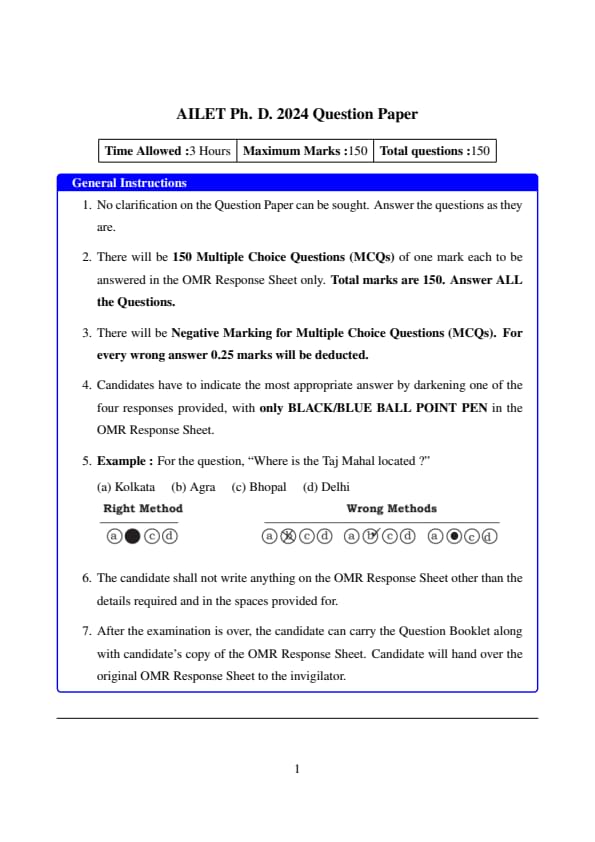
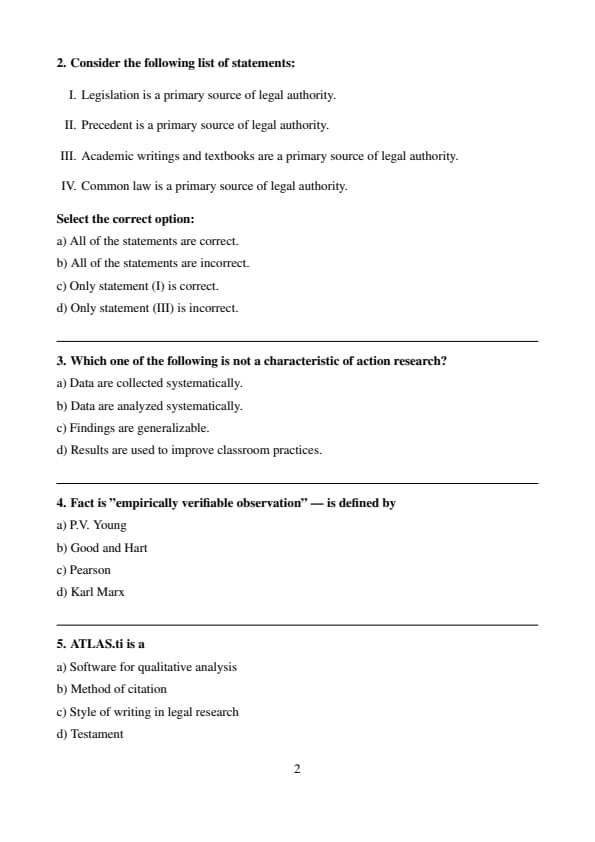
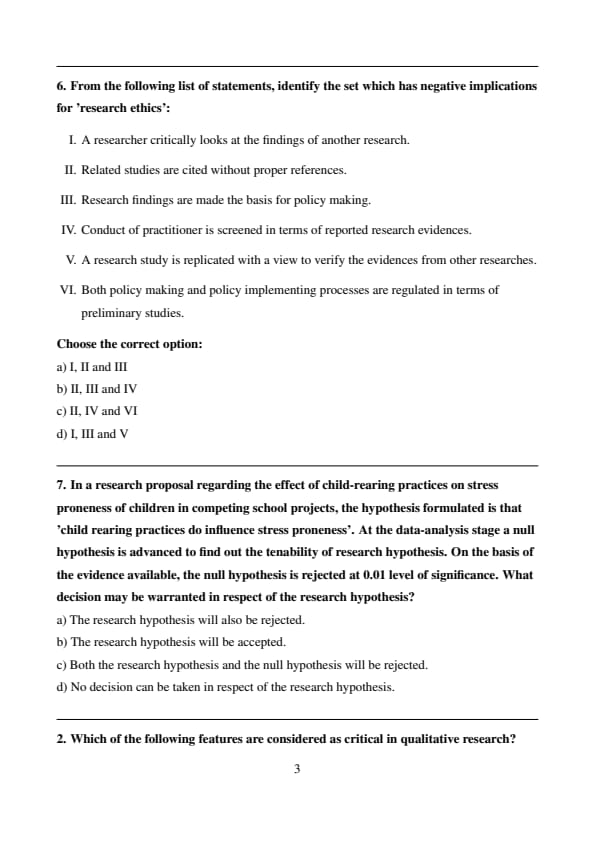
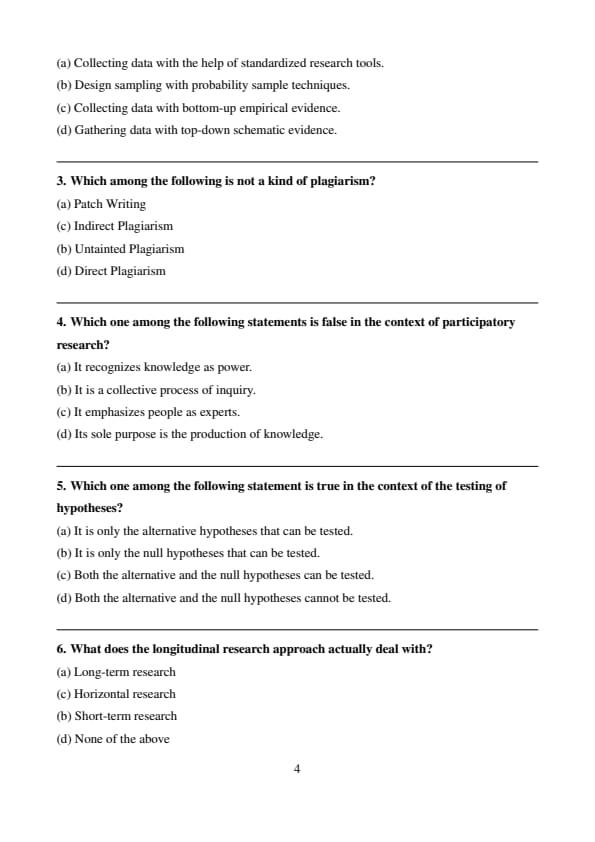

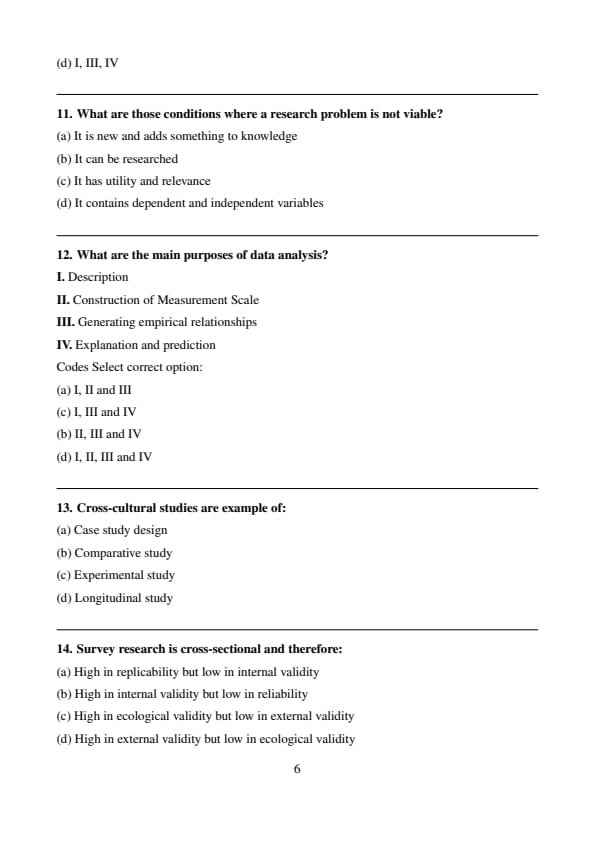


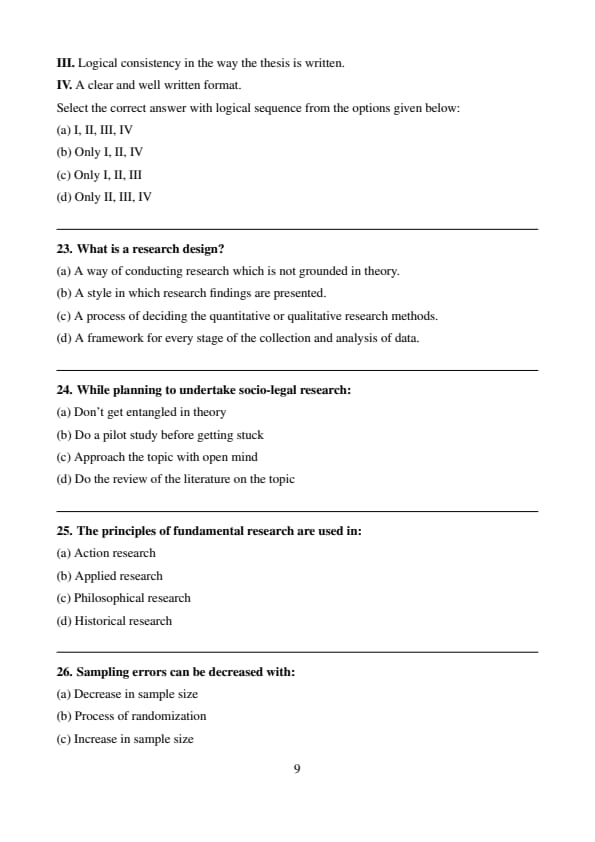



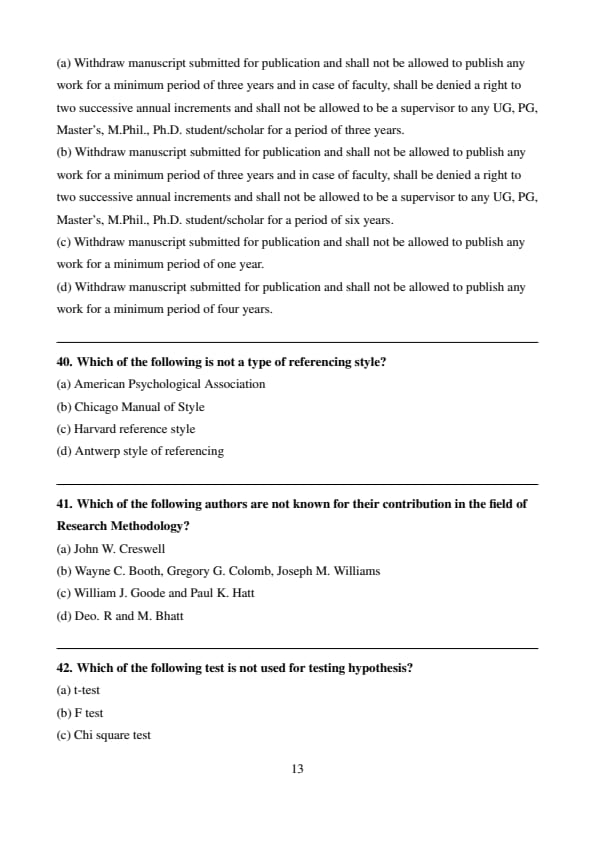


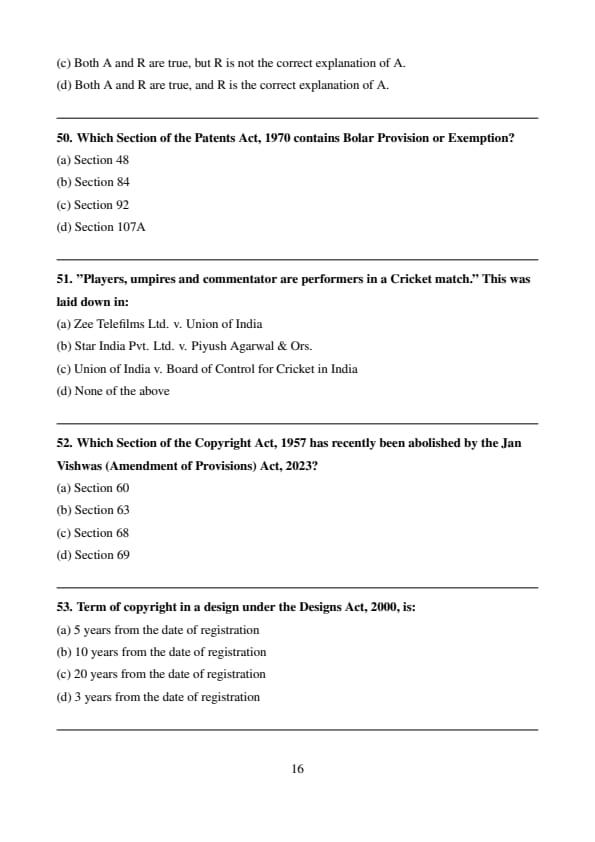

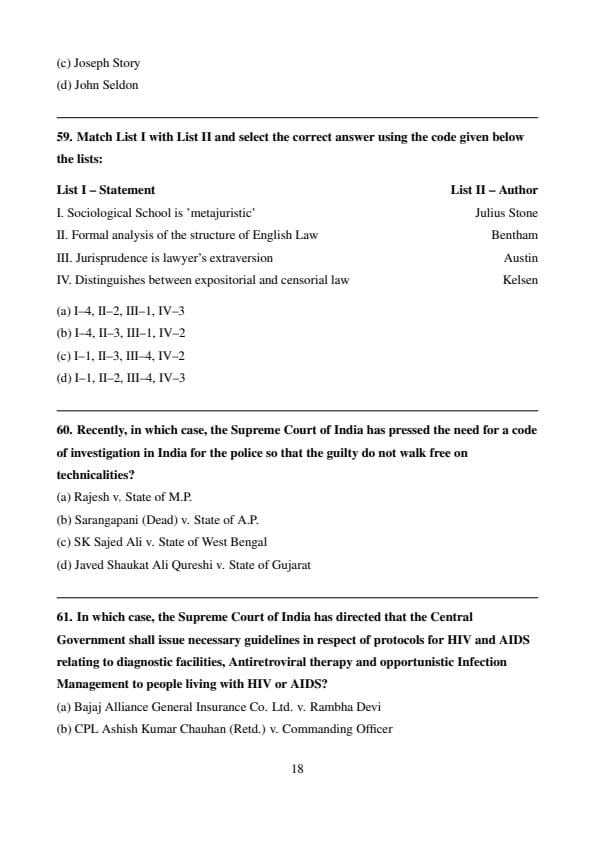
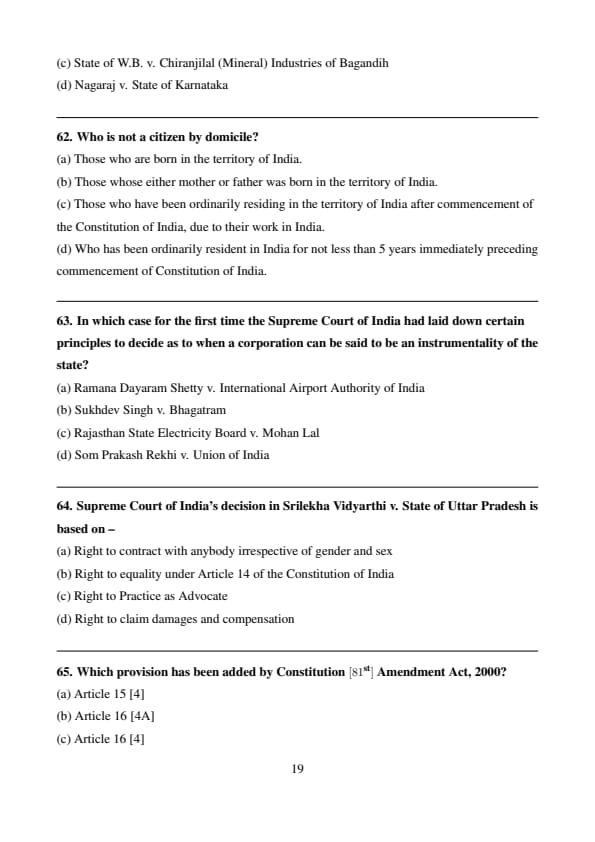
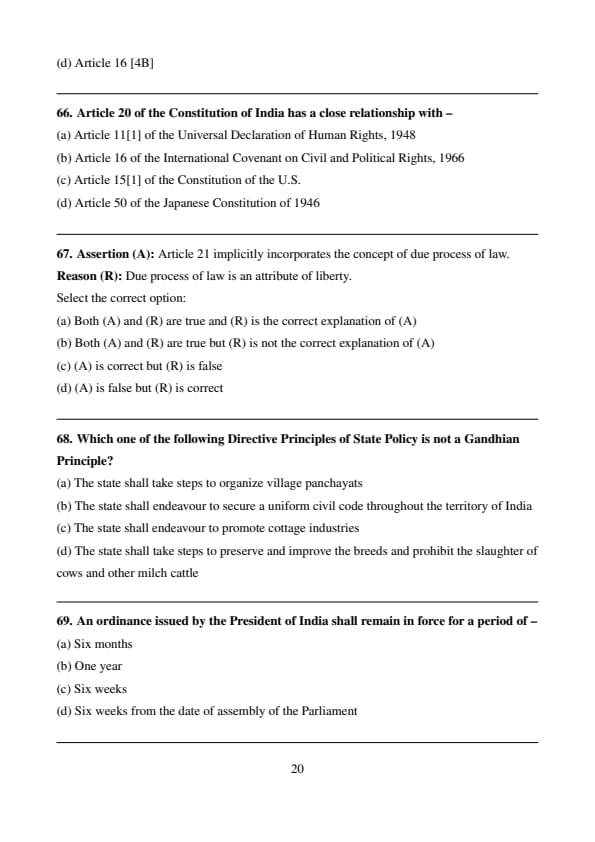
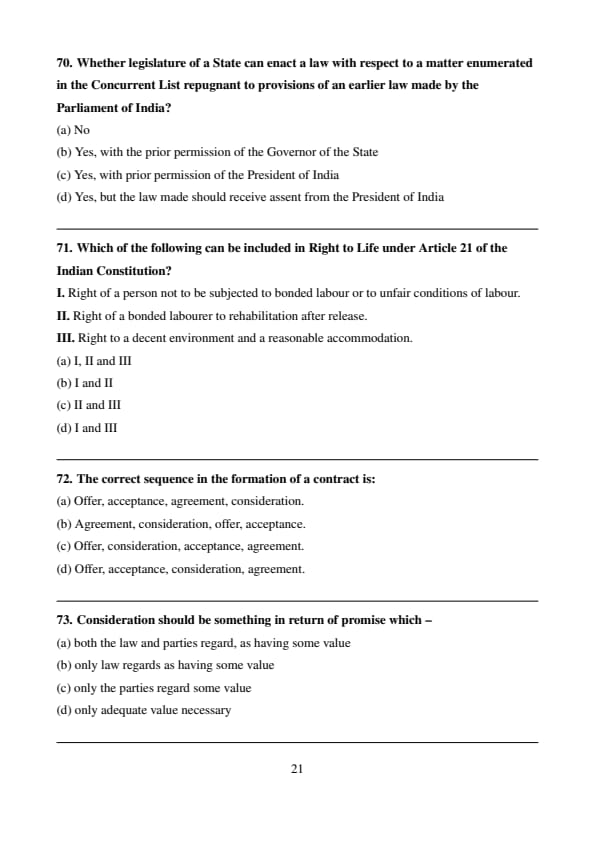

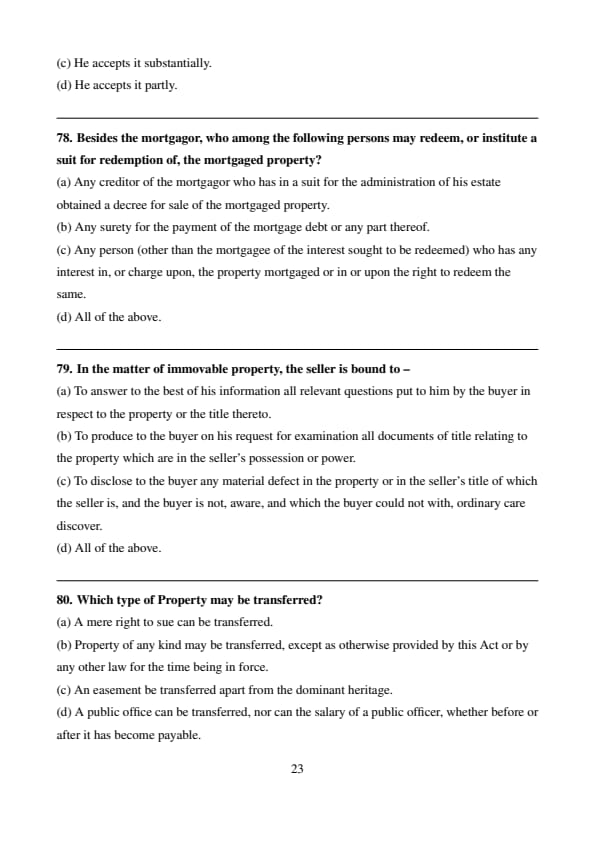
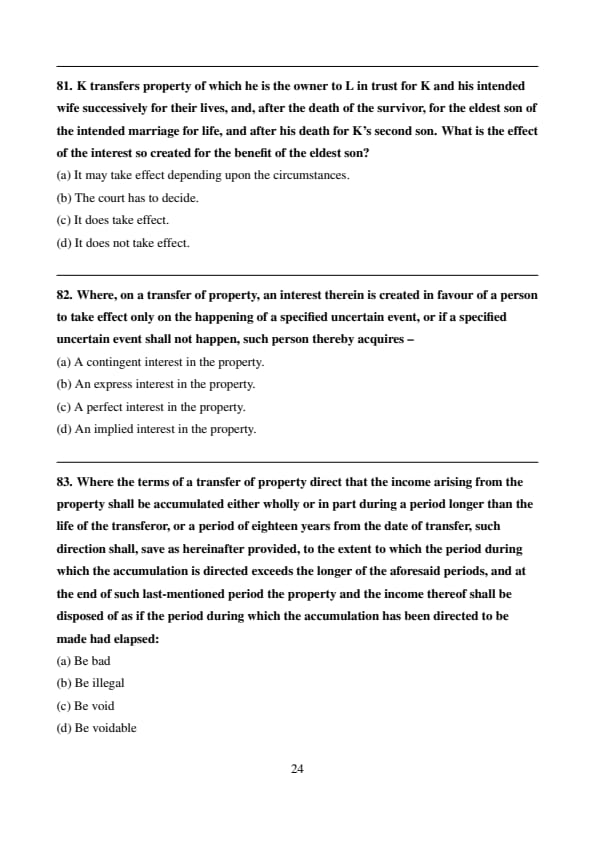

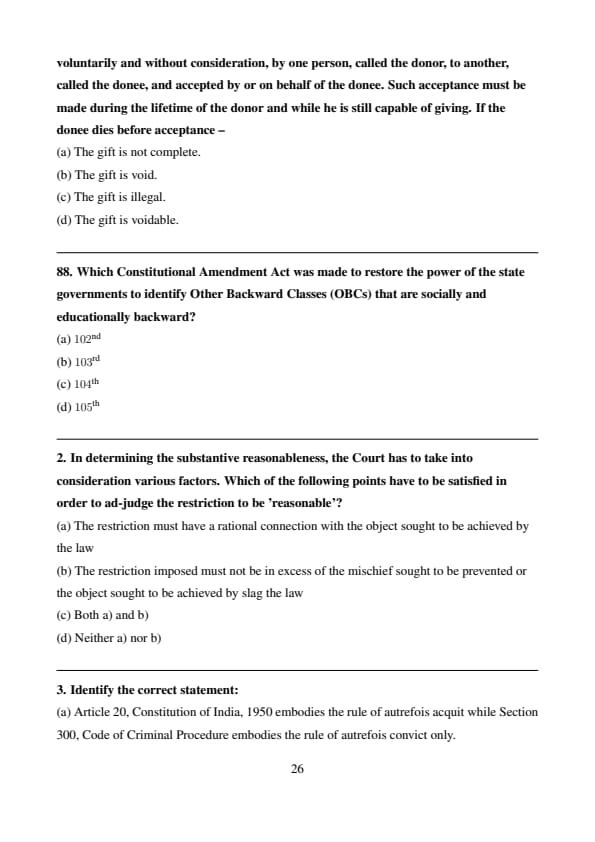
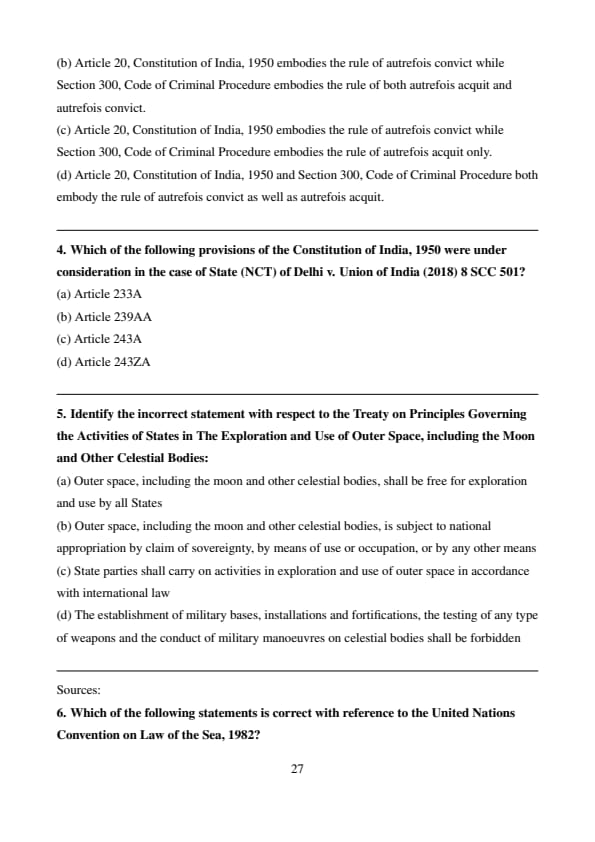
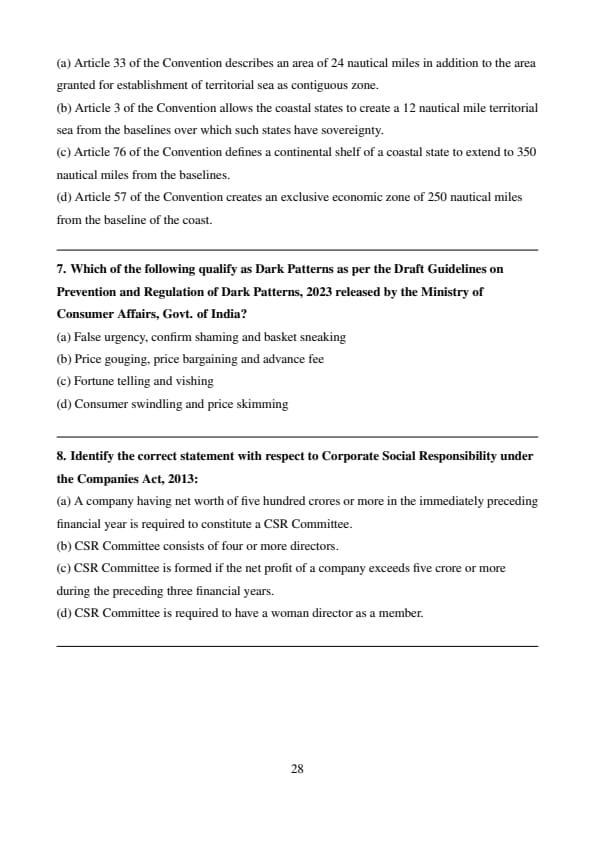



Comments